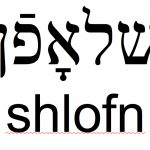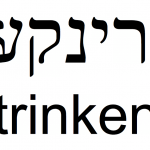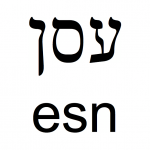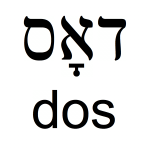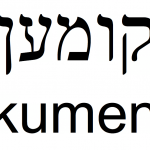Aujourd’hui, nous apprenons à dire “cela” et quelques nouveaux verbes très importants (si j’en juge par le succès de certains posts) et nous continuons à apprendre à les conjuguer.
Today, we learn to say “this” and some very important new verbs (judging by the success of some posts) and we continue to learn to conjugate them.
CECI, CELA = THIS, THAT = DOS = דאָס
MANGER = TO EAT = ES/N = עסן
BOIRE = TO DRINK = TRINK/EN = טרינקען
DORMIR = TO SLEEP = SHLOF/N = שלאָפֿן
VENIR = TO COME = KUM/EN = קומען
Vous vous souvenez? Quand une succession de consonnes rend la prononciation difficile, le yiddish intercale un E ( ע ) pour faciliter l’élocution. C’est le cas aujourd’hui pour les verbes TRINKEN et KUMEN, car TRINKN et KUMN seraient imprononçables.
Do you remember? When a succession of consonants makes the pronunciation too difficult, Yiddish inserts an E (ע) in-between to facilitate speech. This is the case today for the verbs TRINKEN and KUMEN, because TRINKN and KUMN would be unpronounceable.
IL MANGE = HE EATS = ER ES/T = ער עסט
ELLE BOIT = SHE DRINKS = ZI TRINK/T = זי טרינק/ט
IL (neutre) VIENT = IT COMES = ES KUM/T = עס קומ/ט
Comme nous pouvons le constater, la troisième personne du singulier se forme en ajoutant T ( ט ) au radical du verbe. Il en est ainsi pour 99,9% des verbes yiddish. C’est donc facile à retenir.
As we can see, the third person singular is formed by adding T (ט) to the stem of the verb. This is true for 99.9% of Yiddish verbs. It’s easy to remember.
VOUS DORMEZ = YOU SLEEP = IR SHLOF/T = איר שלאָפֿ/ט
VOUS VENEZ = YOU COME = IR KUM/T = איר קומ/ט
VOUS BUVEZ = YOU DRINK = IR TRINK/T = איר טרינק/ט
Nous voyons ainsi que ces verbes ont la même forme à la deuxième personne du pluriel et à la troisième personne du singulier. Il en est ainsi pour 99,9% des verbes.
Nous connaissons maintenant la conjugaison au présent pour la première et la troisième personne du singulier et la deuxième personne du pluriel. Exercez-vous avec tous les verbes appris jusqu’à présent!
Aujourd’hui est donc le bon moment pour apprendre à reconnaître la consonne “Tes” qui s’écrit ט et se prononce comme un T. (voir le post de Regine Bloch-Fiderer sur cette lettre ici: https://www.facebook.com/groups/YiddishPourLesNuls/permalink/503341293181587/ )
We see that these verbs have the same form in the second person of the plural and the third person of the singular. This is so for 99.9% of the verbs.
We now know the conjugation in the present for the first and the third person of the singular and the second person of the plural. Practice with all the verbs learned so far!
So today is the right moment to learn to recognize the consonant “Tes” which cis written ט and is pronounced like a T. (see Regine Bloch-Fiderer‘s post on this letter here:
https://www.facebook.com/groups/YiddishPourLesNuls/permalink/503341293181587/)

